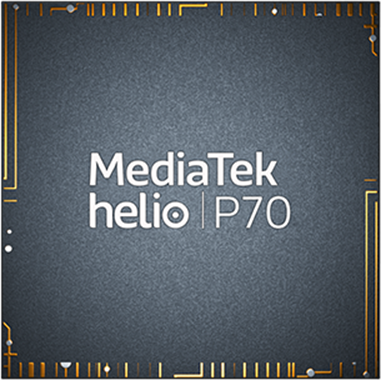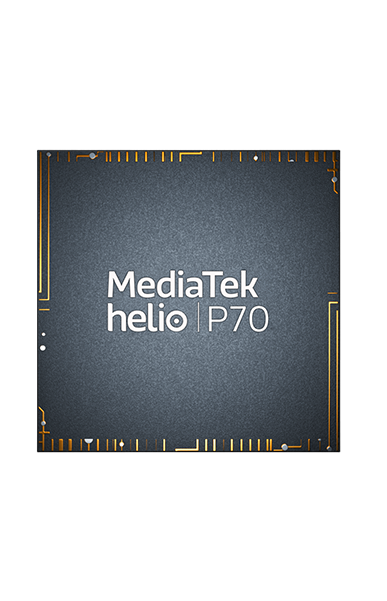
MediaTek
Helio P70
Bigger performance, better cameras, responsive gaming and a masterful multi-core AI


MediaTek Helio P70
at‑a‑glance
Learn more about
MediaTek Helio P70
MediaTek Helio G70
versus the competition
MediaTek Helio
P Series
The MediaTek Helio P70 builds on the P60’s global success and critically acclaimed mix of class‑leading hardware to provide even better experience for users, while brands can build powerful devices with great diversity.
It achieves this through deep power efficiency improvements, further feature upgrades and clock‑speed enhancements. For the user it means longer battery life, a more sustainable, higher performance and up to 4.5ºC lower temperature versus competitor alternatives.
The MediaTek Helio P70 incorporates a powerful Arm Cortex‑A73/A53 octa‑core CPU complex with an impressive Arm Mali‑G72 class GPU. Versus the prior P60, the faster clock speeds generate up to 13% more performance.
MediaTek uses TSMC 12nm FinFET chip production process, which is up to 15% more power-efficient than other 14nm-class products.
Key Features
MediaTek's exclusive CorePilot 4.0 technology manages how tasks are assigned between processing resources, with a power management focus that's on maintaining a sustainable, fast user experience through thermal management, UX monitoring and Energy Aware Scheduling (EAS+).
The multi-core NPU operates up to 525MHz, and combined with MediaTek NeuroPilot enhancements plus a new, intelligent multi-threading scheduler it delivers 10-30% more AI processing efficiency than the previous P60. This means that even within the same performance scope the P70 can support even more complicated AI applications such as human pose detection.
The platform is highly flexible and powerful and provides an exceptionally energy-efficient resource that’s ideal for product differentiation.
Mobile gaming enhancements include unique multi-threading optimizations, as well as a focus on latency improvements in critical user areas to provide the most responsive gameplay experience.
In popular games that frequently generate a heavy load across the SoC, the P70 provides 7% better DOU and up to 35% lower power versus the P60.
For photography, its new high-resolution depth engine gives a 3X boost in depth-mapping performance, which enables smoother 24fps visual bokeh previews while also saving 43mA per second versus competitor alternatives.
With HDR-capable displays and photography a key trend for the latest smartphones, the P70 is unique among peers in its focus on real-time HDR capture, recording and processing and its hardware-driven ability to process RAW HDR images. Other HDR-centric enhancements includes RAW-domain multi-frame HDR capture and Zig-Zag HDR.
MFNR(MFLL) performance has been improved by 20%, meaning faster shot-to-JPEG processing so you’ll never experience a stutter as you capture a burst of photos. Further hardware enhancements include a hardware warping engine used for electronic image stabilization (EIS) that saves 23mA per second vs GPU; an anti-blooming engine prevents white-out; and accurate AI facial detection with intelligent scene detection that generates better 3A (AE, AF and AWB).
In-hand, there’s support for 20:9 displays at Full HD+ resolution that allow users to enjoy the most beautiful and modern smartphone designs with full fascia coverage.
MediaTek’s latest generation 4G LTE WorldMode modem focuses a power-efficient design with latest cellular features and standards.
Its dual 4G SIM enables use of popular VoLTE and ViLTE services on either cellular connection. Compared to traditional calls VoLTE and ViLTE provide the best possible experience, with faster call setup time and noticeably better sound quality. With 4G LTE benefits the second SIM also has faster data connectivity, more reliable coverage and lower power consumption, while also meeting the needs of 4G-only operators.
MediaTek’s innovative Transmission Antenna Switching (TAS 2.0) technology enhances the user experience by using the best antenna combination to provide optimal and sustained signal quality at lowest power.
Specifications
Processor
CPU Type(s)
- Arm Cortex-A53
- Arm Cortex-A73
Max CPU Frequency
2.1GHz
Cores
Octa (8)
CPU Bit
64-bit
Heterogeneous Multi-Processing
Yes
Memory and Storage
Memory Type
LPDDR3, LPDDR4x
Max Memory Frequency
1X LPDDR3 933MHz, 2X LPDDR4x Up to 1800MHz
Max Memory Size
Up to 8GB (LPDDR4x), Up to 4GB (LPDDR3)
Storage Type
eMMC 5.1, UFS 2.1
Connectivity
Cellular Technologies
4G Carrier Aggregation (CA), CDMA2000 1x/EVDO Rev. A (SRLTE), 4G FDD / TDD, HSPA +
Specific Functions
2x2 UL CA, TAS 2.0, HPUE, IMS (VoLTE\ViLTE\WoWi-Fi), eMBMS, Dual 4G VoLTE (DSDS), Band 71
LTE Category
Cat-7 DL / Cat-13 UL
General Connectivity
Bluetooth, FM Radio, GNSS, Wi-Fi
GNSS
Beidou, Galileo, Glonass, GPS, QZSS
Wi-Fi
Wi-Fi 5 (a/b/g/n/ac)
Bluetooth Version
4.2 (Low Energy)
FM Radio
Yes
Camera
Max Camera ISP
20MP + 16MP, 32MP, 48MP Snapshot
Max Video Capture Resolution
1920 x 1080
Capture FPS
Up to 48MP "AI Snapshot", 32MP @ 30fps with ZSD or 16MP @ 90fps
Camera Features
(AI) Facial Detection & Scene Detection; Hardware Warping Engine (EIS); Anti-Blooming Engine; MEMA 3DNR; Multi-Frame Noise reduction; Real-time HDR recording and viewing; Zig-Zag HDR; RAW-domain multi-frame HDR; PDAF
Graphics
GPU Type
Arm Mali-G72 MP3
Max GPU Frequency
Up to 900MHz
Max Display Resolution
2160 x 1080
Video Encoding
H.264
Video Playback
H.264, H.265 / HEVC
MediaTek Technologies
MediaTek Technologies
CorePilot, Imagiq, NeuroPilot, Pump Express, Pump Express Wireless, Response Time Enhancement Technology
AI
AI Accelerator
Yes
Performance
Up to 280GMAC/s
